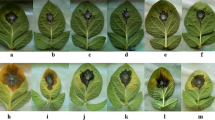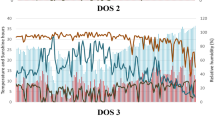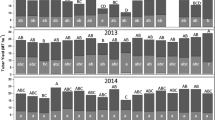Abstract
In field experiments, supplementing chemical haulm destruction (CHD) with cutting off roots resulted in a lower incidence of black scurf and skin damage (ripping off the skin) at harvest date than CHD alone. The lower susceptibility to skin damage at harvest allowed harvesting to beging on an earlier date, when only a few sclerotia ofRhizoctonia solani had developed. Furthermore, black scurf often developed more slowly after haulm destruction if roots had been severed and this enabled harvesting to be postponed.
At harvest, gross yield was highest if roots had not been cut through prior to CHD: the extra weight existed merely of water. Weight loss during storage, however, as well as grading losses resulting from black scurf were greater after CHD alone. This resulted in an equal or even lower net yield after CHD alone than after CHD supplemented by root severing. The favourable effects of supplementing CHD with cutting off roots almost equaled those of the mechanical removal, often called ‘haulm pulling’ or ‘plant pulling’. Factors that may affect the development of black scurf are discussed.
Samenvatting
Pootaardappelen raakten minder bezet met lakschurft en werden minder ontveld bij de oogst na looftrekken of na wortelsnijden plus doodspuiten dan na loofklappen plus spuiten. Al vanaf de derde dag na trekken of wortelsnijden plus doodspuiten was de mate van ontvelling zo gering, dat met het oogsten kon worden begonnen. Op zo'n vroeg tijdstip na loofdoding konden knollen worden geoogst met nog weinig lakschurft, want de stimulering van lakschurft werd pas zichtbaar vanaf 7 à 10 dagen na loofdoding. Lakschurft ontwikkelde zich het traagst na looftrekken. Ook wortelsnijden bij het doodspuiten gaf meestal een tragere ontwikkeling van lakschurft dan klappen plus spuiten. Daardoor konden na wortelsnijden plus doodspuiten en vooral na looftrekken op nog latere tijdstippen knollen met weinig lakschurft worden geoogst.
Na klappen plus spuiten was het bruto gewicht bij de oogst het hoogst. Dat meergewicht bleek louter uit water te bestaan en het verloop in knolvochtgehalte leek erop te wijzen dat de wortels nog gedurende een week na doodspuiten blijven functioneren. Dat gaf wel knollen met een hoger vochtgehalte die meer ontvelden en meer vocht en dus gewicht verloren. Dit groter gewichtsverlies bij bewaren en de hogere leesverliezen door lakschurft deden de meeropbrengst teniet: zo werd het netto knolgewicht na klappen plus spuiten, al naar gelang het moment van oogsten, meestal gelijk aan, of lager dan het netto knolgewicht na het trekken of na wortelsnijden plus doospuiten. In dit artikel worden de factoren besproken, die mogelijk van invloed zijn op de ontwikkeling van lakschurft.
Similar content being viewed by others
References
Blair, I.D., 1943. Behaviour of the fungusRhizoctonia solani Kühn in the soil. Ann. appl. Biol. 30: 118–127.
Bouman, A., Bouma, J., Mulder, A. & Roosjen, J., 1983. Effecten van tijdstip en wijze van loofvernietiging op de ontvellingsgevoeligheid en op de bezetting van pootaardappelen met Rhizoctonia. IMAG publicatie nr. 181, 39 pp. (with English summary).
Braue, C.A., Wample, R.L., Kolattukudy, P.E. & Dean, B.B., 1983. Relationship of potato tuber periderm resistance to plant water status. Amer. J. Pot. Res. 60: 827–837.
Brown, N.J., Fountaine, E.R. & Holden, M.R., 1965. The oxygen requirement of crop roots and soils under near field conditions. J. agric. Sci. 64: 195–203.
Burton, W.G., 1966. Post harvest physiology. In: Burton, W.G., The potato. H. Veenman & Zonen B.V., Wageningen, the Netherlands. p. 223–231.
Cary, J.W., 1985. Potato tubers and soil aeration. Agron. J. 77: 379–383.
Dijst, G., 1985. Investigations on the effect of haulm destruction and additional root cutting on black scurf on potato tubers. Neth. J. Pl. Path. 91: 153–162.
Dijst, G., Mulder, A., Roosjen, J., Bouman, A. & Loon, C.D. van, 1985. De gevolgen van wortelsnijden plus doodspuiten op lakschurft, ontvelling, opbrengst en oogstperiode bij pootaardappelen. Gewasbescherming 5: 145–152.
Finney, E.E., Jr. & Findlen, H., 1967. Influence of preharvest treatments upon turgor of Katahdin potatoes. Amer. Pot. J. 44: 383–386.
Lewis, J.A., 1976. Production of volatiles from decomposing plant tissues and effect of these volatiles onRhizoctonia solani in culture. Can. J. Microbiol. 22: 1300–1306.
Meijers, C.P., Veldhuisen, G. van & Mulder, C., 1982. De gewichtsverliezen van pootgoed na ontvelling bij ideale en minder ideale bewaring. De Pootaardappelwereld 35: 3–7.
Reestman, A.J. & Schepers, A., 1955. Proeven over de vergelijking van het trekken van aardappelloof en doodspuiten (voornamelijk na mechanisch klappen) van het loof in de jaren 1953 en 1954. Gestencilde Mededelingen nr. 4, Centraal Instituut voor Landbouwkundig Onderzoek. 22 pp. (with English summary0.
Sherwood, R.T., 1970. The physiology ofRhizoctonia solani. In: Parmeter, J.R., Jr., (Ed.),Rhizoctonia solani: Biology and pathology. University of Callifornia Press, Berkeley etc., p. 69–92.
Spencer, D. & Fox, R.A., 1979. The development ofRhizoctonia solani Kühn on the underground parts of the potato plant. Pot. Res. 22: 29–39.
Werner, H.O., & Dutt, J.O., 1941. Reduction of cracking of late crop potatoes at harvest time by root cutting or vine killing. Amer. Pot. J. 18: 189–208.
Author information
Authors and Affiliations
Rights and permissions
About this article
Cite this article
Dijst, G., Bouman, A., Mulder, A. et al. Effect of haulm destruction supplemented by cutting off roots on the incidence of black scurf and skin damage, flexibility of harvest period and yield of seed potatoes in field experiments. Netherlands Journal of Plant Pathology 92, 287–303 (1986). https://doi.org/10.1007/BF01977591
Accepted:
Issue Date:
DOI: https://doi.org/10.1007/BF01977591




